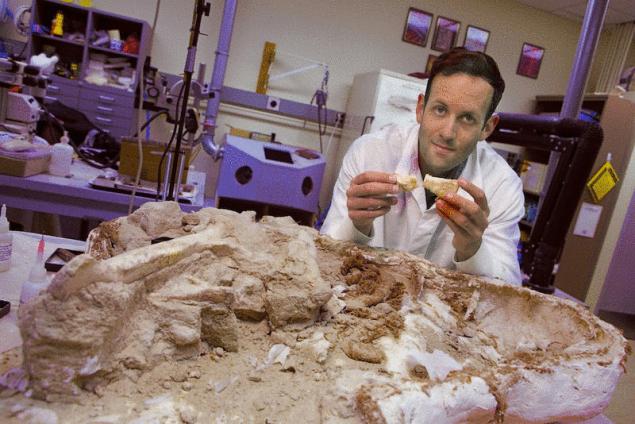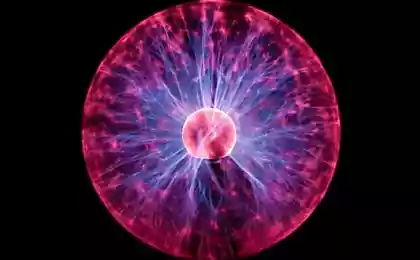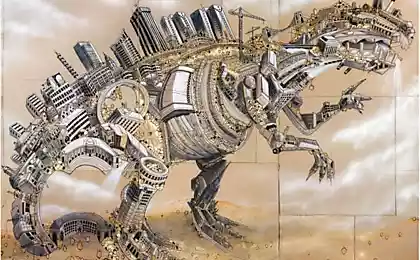494
Dinosaurs could be warm-blooded
When the dinosaurs could be cold blooded kings of the Mesozoic era. But a new study of their rate of growth suggests that these prehistoric monsters grow as fast as mammals and therefore warm-blooded creatures. However, not all agree with these results, and some paleontologists believe that dinosaurs fall between cold-blooded (ectothermic) and warm-blooded (endothermal) and have intermediate blood (mesoderma).

Dinosaurs are considered reptiles, so scientists have suggested that these animals were cold blooded, like their congeners, that is, regulate their body temperature depending on environment. Sluggish metabolism of this cold-blooded dinosaur has led to the fact that he slowly moved his limbs. The warm-blooded dinosaur could control their body temperature and had a faster metabolism. Such a crank would be fun to ride around the house.
Scientists have argued on the topic of thermoregulation of dinosaurs for decades, but the flames were fanned by publication in 2014 in the journal Science, in which the authors pointed out that the dinosaurs probably were mezotermale. Moreover, previous research activity of the dinosaurs, energy consumption and their teeth have also found the arguments in favor of teplokrovnosti these creatures. This question is not only academic; the answer could provide us with a complete picture of how dinosaurs lived and died, scientists say.
In seeking to resolve disputes scientists studied the fossilized bones of dinosaurs. These bones have growth rings which like tree rings show how fast or slow growing animals. Scientists compared the growth rates of dinosaurs with the bones of extinct and living animals, and found that dinosaurs were in the middle of the continuum of growth between warm-blooded and cold-blooded creatures.

But this research has two big problems, says Michael D Emik, research instructor of anatomical Sciences Medical school at the University of stony brook in new York. When D Emik re-analyzed the data using other techniques, he "was surprised to find absolutely other conclusions. Dinosaurs not to fall into an intermediate category between warm-blooded and cold-blooded animals, they are a perfect fit — from the point of view of metabolism and growth in the environment of mammals.
First, D Erik found that scientists who published the study in 2014, expected daily growth, but the growth rings of the dinosaurs rather describe annual growth (as in many organisms). This helped them to standardize comparisons with other animals, particularly those that reach adulthood in a year, and those who need years to reach this age, he says.
"The problem pointed to my work, is that the animal grows for six months, on average — for example, during cold or dry seasons. Therefore, it is necessary to divide not on 365, and 180, which doubles the growth rate of the dinosaurs."
Second, scientists of the original study are not grouped birds (which are warm-blooded) dinosaurs, although the birds likely evolved from the theropod group of carnivorous bipedal animals, one of which was Tyrannosaurus rex.
"To separate what we usually consider "dinosaurs", from the birds in the statistical analysis is inappropriate, since birds are dinosaurs — it's just dinosaurs that are not extinct," reported D Emik in a statement.
When a scientist doubled the growth rate of dinosaurs and added to the calculations of birds, dinosaurs in their growth rates became more similar to the warm-blooded mammals.
Prevaricator original research, as one would expect, the arguments do not agree — response to statement D Emika was published in Science.
"We would like to state clearly that I do not agree with his Central criticism, and we emphasize commitment to all of our original conclusions," said John Grady, a leading researcher of the original work, doctoral candidate at the University of new Mexico. According to Grady, the arguments D Emika contradictory. Many animals grow seasonal, and so the rate of growth of all vertebrates in the study, and not only the dinosaurs should be doubled. In this case, the relative differences remain and the dinosaurs continue to fall in the gap between endothermy and ectothermy, says Grady.

In addition, in the initial study, scientists have grouped birds from flightless dinosaurs and Archaeopteryx (a transitional species between dinosaurs and birds) due to the significant differences between them.
"Evidence of growth is pretty transparent, says Grady. — Dinosaurs did not have such a rabid metabolism, as their live feathered relatives."
Expert maniacco for other scientists, they are very sympathetic to new insights about teplokrovnosti giant lizards. The researchers note that the growth rate of dinosaurs may not be as consistent as in other animals, and it would be fair to relate birds to dinosaurs. But for the final arrangement of the points in the issues of regulation needed more evidence, experts say.
On the one hand, the two studies rely on a single dataset that includes the bones of dozens of dinosaurs almost 21. (It is generally known, more than 700 species of dinosaurs). This dataset also includes the entire Mesozoic, a period of time, spanning over 180 million years.
"When you say "the dinosaurs of the Mesozoic" you're talking about a huge array of animals that lived for a long time," says Kenneth Lacovara, Professor of paleontology and Geology at Drexel University in Philadelphia; he did not participate in these studies. Perhaps some dinosaurs were warm-blooded, and others mezotermale, but the necessary tests cladistic groups (species that share a common ancestor), habitats and time periods to highlight different metabolisms and growth rates, says Lacovara.
In addition, scientists need more research on the coldly - or teplokrovnosti dinosaurs before they can make a confident choice in favor of one of three types of activity.
"There are many other signs that flightless dinosaurs were very active and energetic life, comparable to birds and mammals, says Lacovara. For example, some studies of the anatomy suggest that they quickly ran, and the other left paths during migration, like many mammals. — I think the new analysis is a step in the right direction. Need more nuances and more data."published
Source: hi-news.ru

Dinosaurs are considered reptiles, so scientists have suggested that these animals were cold blooded, like their congeners, that is, regulate their body temperature depending on environment. Sluggish metabolism of this cold-blooded dinosaur has led to the fact that he slowly moved his limbs. The warm-blooded dinosaur could control their body temperature and had a faster metabolism. Such a crank would be fun to ride around the house.
Scientists have argued on the topic of thermoregulation of dinosaurs for decades, but the flames were fanned by publication in 2014 in the journal Science, in which the authors pointed out that the dinosaurs probably were mezotermale. Moreover, previous research activity of the dinosaurs, energy consumption and their teeth have also found the arguments in favor of teplokrovnosti these creatures. This question is not only academic; the answer could provide us with a complete picture of how dinosaurs lived and died, scientists say.
In seeking to resolve disputes scientists studied the fossilized bones of dinosaurs. These bones have growth rings which like tree rings show how fast or slow growing animals. Scientists compared the growth rates of dinosaurs with the bones of extinct and living animals, and found that dinosaurs were in the middle of the continuum of growth between warm-blooded and cold-blooded creatures.

But this research has two big problems, says Michael D Emik, research instructor of anatomical Sciences Medical school at the University of stony brook in new York. When D Emik re-analyzed the data using other techniques, he "was surprised to find absolutely other conclusions. Dinosaurs not to fall into an intermediate category between warm-blooded and cold-blooded animals, they are a perfect fit — from the point of view of metabolism and growth in the environment of mammals.
First, D Erik found that scientists who published the study in 2014, expected daily growth, but the growth rings of the dinosaurs rather describe annual growth (as in many organisms). This helped them to standardize comparisons with other animals, particularly those that reach adulthood in a year, and those who need years to reach this age, he says.
"The problem pointed to my work, is that the animal grows for six months, on average — for example, during cold or dry seasons. Therefore, it is necessary to divide not on 365, and 180, which doubles the growth rate of the dinosaurs."
Second, scientists of the original study are not grouped birds (which are warm-blooded) dinosaurs, although the birds likely evolved from the theropod group of carnivorous bipedal animals, one of which was Tyrannosaurus rex.
"To separate what we usually consider "dinosaurs", from the birds in the statistical analysis is inappropriate, since birds are dinosaurs — it's just dinosaurs that are not extinct," reported D Emik in a statement.
When a scientist doubled the growth rate of dinosaurs and added to the calculations of birds, dinosaurs in their growth rates became more similar to the warm-blooded mammals.
Prevaricator original research, as one would expect, the arguments do not agree — response to statement D Emika was published in Science.
"We would like to state clearly that I do not agree with his Central criticism, and we emphasize commitment to all of our original conclusions," said John Grady, a leading researcher of the original work, doctoral candidate at the University of new Mexico. According to Grady, the arguments D Emika contradictory. Many animals grow seasonal, and so the rate of growth of all vertebrates in the study, and not only the dinosaurs should be doubled. In this case, the relative differences remain and the dinosaurs continue to fall in the gap between endothermy and ectothermy, says Grady.

In addition, in the initial study, scientists have grouped birds from flightless dinosaurs and Archaeopteryx (a transitional species between dinosaurs and birds) due to the significant differences between them.
"Evidence of growth is pretty transparent, says Grady. — Dinosaurs did not have such a rabid metabolism, as their live feathered relatives."
Expert maniacco for other scientists, they are very sympathetic to new insights about teplokrovnosti giant lizards. The researchers note that the growth rate of dinosaurs may not be as consistent as in other animals, and it would be fair to relate birds to dinosaurs. But for the final arrangement of the points in the issues of regulation needed more evidence, experts say.
On the one hand, the two studies rely on a single dataset that includes the bones of dozens of dinosaurs almost 21. (It is generally known, more than 700 species of dinosaurs). This dataset also includes the entire Mesozoic, a period of time, spanning over 180 million years.
"When you say "the dinosaurs of the Mesozoic" you're talking about a huge array of animals that lived for a long time," says Kenneth Lacovara, Professor of paleontology and Geology at Drexel University in Philadelphia; he did not participate in these studies. Perhaps some dinosaurs were warm-blooded, and others mezotermale, but the necessary tests cladistic groups (species that share a common ancestor), habitats and time periods to highlight different metabolisms and growth rates, says Lacovara.
In addition, scientists need more research on the coldly - or teplokrovnosti dinosaurs before they can make a confident choice in favor of one of three types of activity.
"There are many other signs that flightless dinosaurs were very active and energetic life, comparable to birds and mammals, says Lacovara. For example, some studies of the anatomy suggest that they quickly ran, and the other left paths during migration, like many mammals. — I think the new analysis is a step in the right direction. Need more nuances and more data."published
Source: hi-news.ru























